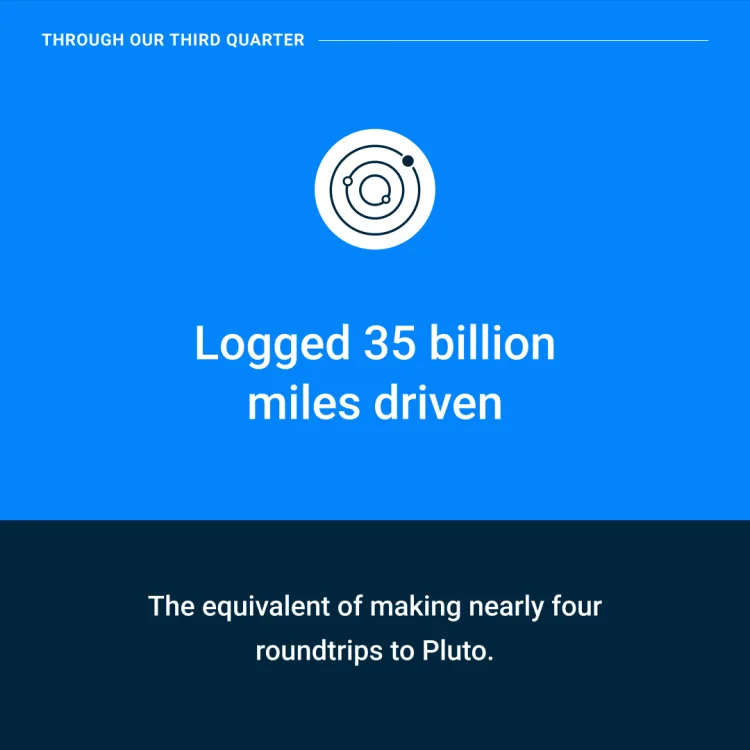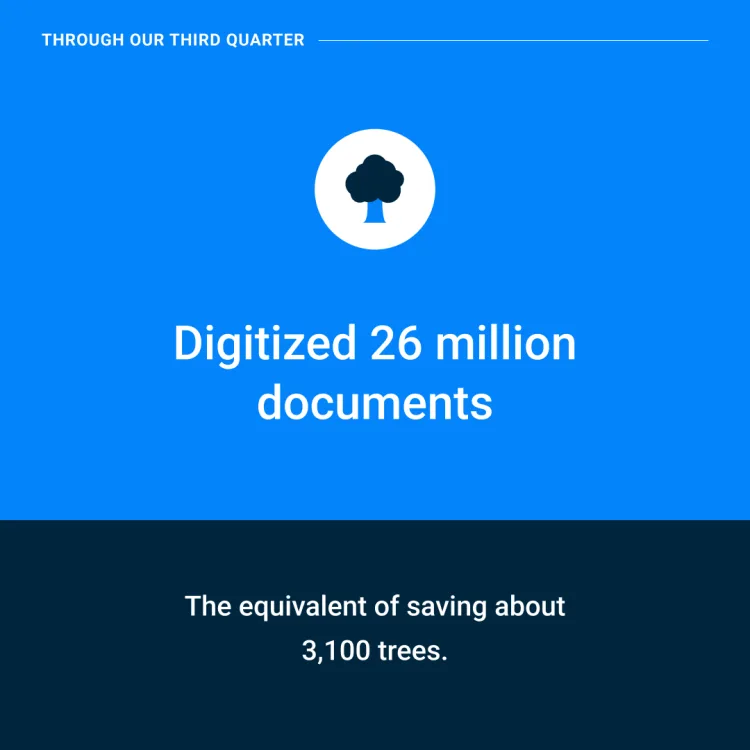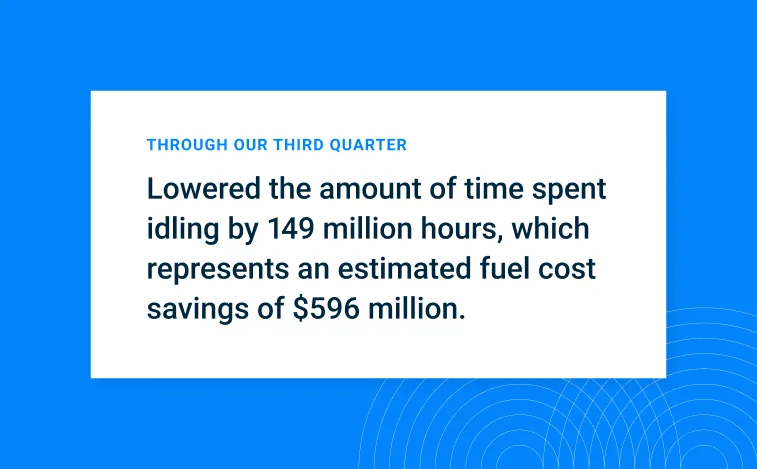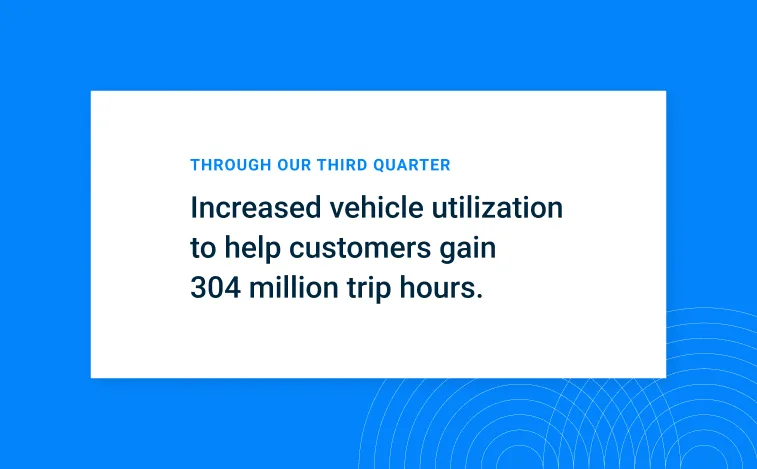Data Insights
How Samsara Transformed Customer Operations in 2022 and Big Ideas for What's Next
December 8, 2022

Get the latest from Samsara
Subscribe nowToday, costs for almost every business are on the rise, but increases for the operations industry have been particularly steep—fuel costs are up 35%, repair and maintenance costs are 18% higher, and driver wages have risen almost 11%. In challenging economic times like these, leaders start to ask if the right investments are being made in the right places, and look to uncover where spending can be optimized. As companies prepare for the future, the most important question becomes: What gives fast, real value to a business and its customers?
Over the past year, Samsara has delivered insights to help a growing number of organizations with physical operations answer this fundamental question. Samsara collects trillions of data points annually, providing an aggregated view of all the unique ways that customers use the Samsara Connected Operations Cloud to improve the safety, efficiency, and sustainability of their operations. The data can also tell a bigger story about trends across the industry as a whole. In this post, we'll take a deeper dive into what we saw this year as well as hear predictions from our leaders about what's next in 2023.
A Year of Growth
By any measure, customer usage, and the Samsara platform as a whole, are expanding. To give you some idea of just how much, here are several metrics that we've captured so far this fiscal year. Through our third quarter, Samsara has:

Logged 35 billion miles driven, a 54% year-over-year (YoY) increase, the equivalent of making nearly four roundtrips to Pluto.
Processed 451 million hours of dash cam footage, a 89% YoY increase, which would take 51,484 years to watch from start to finish.
Digitized 26 million documents, a 70% increase YoY, or the equivalent of saving about 3,100 trees.
Received 36 billion API calls to Samsara's Connected Operations Cloud, a YoY increase of 60%, which is just over 1,140 API calls every second every day of the year.
Averaged 207,000 daily active users* on the Samsara Driver App, a 59% YoY increase, enough people to fill every seat in Yankee Stadium almost four times.

Samsara works every day to make connected operations a reality for thousands of organizations around the globe. The YoY growth seen above is largely driven by the increase in new customers and usage of the Samsara platform, concrete evidence of just how quickly physical operations companies are adopting technology, such as telematics and cameras, to operate more effectively.
In 2022, we made several product enhancements to help customers further realize the benefits that connected operations can deliver. A few include:
Proactive Driver Coaching, a solution that evolves our existing in-cab coaching capabilities to help drivers build safe habits in real time, before an incident occurs. In-Cab Nudges™, for example, alert drivers to self-correct risky behaviors on their own, in real time, before a safety event is created for manager review.
Driver Workflows, a tool that gives managers the ability to create customized mobile workflows for the Samsara Driver App to onboard new workers, reduce errors, and streamline drivers’ days.
Multi-Stop ETAs, a feature that provides dispatch and operations teams with accurate arrival times at stops along all active routes, improving communication with customers and exceeding service expectations.
You can learn more about our 2022 product releases here.
Looking beyond Samsara's products, we also rely on partners to enhance the platform experience and give customers as much flexibility as possible. In 2022, we celebrated Samsara's 200th partner integration, making us the largest open ecosystem for physical operations. As our platform and ecosystem continue to grow, the Samsara Connected Operations Cloud is quickly becoming an essential system of record for the industry.
A Year of Impact
For Samsara, however, the most important metric is the success of our customers. To discover how our technology has helped organizations over the past year, we aggregated anonymized data from a select cohort of 2,500+ customers globally and identified several insights**. In the past year, these Samsara customers:

Lowered the amount of time spent idling by 149 million hours, which represents an estimated fuel cost savings of $596 million. Customers in the cohort reduced idling rates from 9.4% to 5.8%.
Increased vehicle utilization to help customers gain 304 million trip hours, allowing them to increase available hours from their fleets without needing to spend more on new vehicles. In terms of percentage increases, customers in the cohort increased their vehicle utilization by 2%.
Reduced crashes by 9% per 1,000 miles driven. Given that the average cost of a commercial trucking injury crash is $148,270, this 9% reduction indicates substantial cost savings for customers.

As these results show, even seemingly incremental gains have a big impact on crashes, fuel consumption, and vehicle usage that can lead to significant cost savings and safety improvements. But what do these gains look like for companies on the ground? Here’s how three customers are using the Samsara Connected Operations Cloud to navigate challenges this year:
Lowering the skyrocketing cost of doing business: Summit Materials was tracking fuel usage based on fuel purchases, not actual use. With Samsara Vehicle Gateways and Fuel Reporting, the company was able to monitor vehicle performance, reduce idle time, and improve fuel efficiency, helping Summit Materials save approximately $1 million per year.
Making the most of existing assets: Artera couldn't monitor the efficiency and performance of their fleet of 8,000 vehicles. Using Samsara, the company was able to right-size their fleet and save more than $1 million. In addition, Artera sold $10 million in underutilized equipment, allowing them to invest in other areas of the business.
Attracting and retaining talent amid a historic labor shortage: Chalk Mountain wanted to become a sought-after place to work. After implementing Samsara, the company has built a culture of safety where drivers are celebrated, rewarded, and protected from false claims. As a result, Chalk Mountain has seen better morale and a 15% improvement in driver retention.
What’s Next for 2023
It's important to mark the tangible impacts that Samsara's technology has delivered for customers over the past year. However, a big part of our success also lies in always looking ahead to anticipate the challenges and opportunities that our customers—and the industry as a whole—will face in the future.
To better understand the trends that will shape 2023, we asked several leaders at Samsara to weigh in. Here are their predictions.

“Real-time data made directly accessible to employees will provide a competitive advantage.”
—Jeff Hausman, Chief Product Officer
"With real-time insights, alerts, and reports made available at their fingertips, frontline employees can make data-driven decisions and accelerate time to action. Companies that take this approach will gain a competitive advantage when it comes to operational efficiency, employee retention, and more."
Against the backdrop of a challenging economic climate, Hausman predicts that organizations that give employees access to real-time data will be better equipped to respond to business problems. Organizations that treat fuel costs, supply chain pressure, and other issues as data problems and empower individual employees to solve them will be more successful.

“Career pathing and technology for professional drivers will help organizations win the talent war.”
—Sarah Patterson, Chief Marketing Officer
"Organizations that show they’re invested in career pathing and providing a modern and safer experience through technology will be the best at attracting and retaining drivers.”
Patterson predicts that instead of letting decades of wisdom walk out, organizations will carve new career paths for drivers who no longer desire to be behind the wheel. For example, rather than retiring, older drivers will take on training roles, bringing more value to organizations and accelerating how quickly new drivers can learn the ropes. Using technology solutions in their day-to-day will also make the position more attractive to a younger, digital-native cohort who will help solve the ongoing driver shortage.

“CIOs will eventually act as the primary role for managing operations.”
—Stephen Franchetti, Chief Information Officer
“Historically, the worlds of IT and OT have been siloed because they solved a different set of business problems. Now, the proliferation of data from the rise of IIoT, IoT, and AI has created an environment where all problems—whether physical or digital—increasingly rely on technology to be solved.”
The industrial sector continues to become more connected. As a result, Franchetti predicts that in 2023 many business decisions that impact physical operations will be made with a digital-first mindset. Eventually, this convergence will result in CIOs acting as the primary role for managing operations.

“Real-world data will provide the signposts for further EV adoption.”
—Philip van der Wilt, Vice President, EMEA
“Fleets are actively planning their EV transition today with many receiving their first vehicles in 2023. This will give fleet leaders invaluable experience in planning, deploying, and managing an electric fleet.”
Getting more EVs on the road is good for sustainability, but as van der Wilt predicts, it will also provide valuable data that other leaders can use to make their own EV deployments more effective. Leaders will have access to real-world insights that they can use to shape their EV adoption roadmaps and have a true impact on their bottom lines. Backed by data, first-movers will give more companies around the world the confidence to make the shift to EVs.
Learn More About Connected Operations Trends
To learn more about our data team's discoveries, read Samsara's Data Insights series. Each post is packed with information on trends—from safety, to labor, to AI, and more—that are shaping the industry.
Methodology
Comparison estimates: The distance from Earth to Pluto is 4.67 billion miles; a single tree can produce about 8333 letter-sized pages; the capacity of Yankee Stadium is 52,325; for fuel savings, we assumed $5 per gallon and 0.8 gallons of gas used per hour of idling.
*Samsara Driver App daily active users: Samsara measures daily active users by identifying, for each day during the measurement period, the daily number of distinct driver IDs who interacted with our Driver App that day. We then take the simple average of the daily user count across the entire measurement period.
**Customer cohort findings: The statistics shown are based on our review of anonymized historical data of 2,500+ Samsara customers globally, comparing the number of hours of idling, the number of crashes, and the number of vehicle utilization hours for this cohort for the first three quarters of fiscal 2023 to the same period during the year prior. Each customer in the cohort evaluated has driven at least 2,000 miles in the first three quarters of 2022 and had either a Samsara Vehicle Gateway or a Samsara Vehicle Gateway and Video-based Safety solution during both measurement periods.
Get the latest from Samsara
Subscribe now









